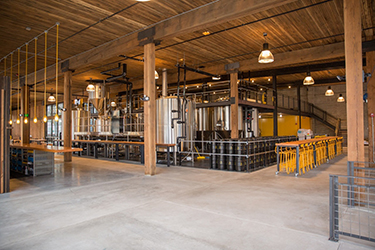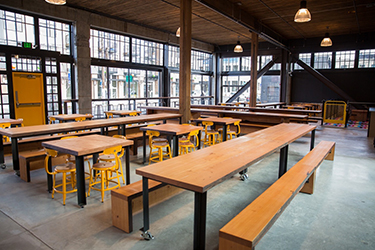|
Subscribe / Renew |
|
|
Contact Us |
|
| ► Subscribe to our Free Weekly Newsletter | |
| home | Welcome, sign in or click here to subscribe. | login |
News
| |
January 4, 2016
Tips from an engineer on making your old building seismically sound
Journal Staff Reporter
Marjorie Lund has always been interested in architecture, but her real talent is math.
So she became a structural engineer, and focuses on the “hidden bones” that make buildings stand up. “I found out I definitely had more of the engineering mentality,” she said, “and just loved supporting architecture.”
Her first job was at Seattle's Skilling Ward Magnusson Barkshire, now Magnusson Klemencic Associates. She worked on lots of high-rises in the 1980s and eventually became a vice president.
In 1997, Lund opened a structural engineering firm on Vashon with Kerry Everton. In 2009, the firm won an award from the American Institute of Steel Construction for an innovative design at Swedish Orthopedic Institute.
In 2012, Lund and Peter Opsahl, with whom she had worked at Skilling, opened Lund Opsahl structural engineering in Pioneer Square.
Both are principals, but Lund is majority owner, which helps it get jobs with public agencies and companies as a women-owned business.
Lund said 2014 revenues were $1.4 million, and should be about $2 million for 2015.

The staff of 13 works on new construction and renovations. Projects include the 19-story Washington Place apartment and hotel tower in Tukwila and a 200,000-square-foot expansion of Pro Sports Club in Bellevue. Major renovations in Seattle include Optimism Brewery, Mezcaleria Oaxaca and University of Washington buildings.
Lund talked with the DJC about how to make older buildings safer.
1. How do you get the most bang for your buck?
Secure the bricks! If your building has masonry walls — bricks, concrete masonry units, or clay tiles — anchor the walls or encapsulate them so they don't fall.
Floors and roofs supported by unreinforced masonry walls could collapse if the masonry falls. Falling bricks and partial building collapse are the biggest immediate risks to people in an earthquake.
Unreinforced masonry walls are more common in pre-1970s buildings. They are usually repaired by bolting the exterior walls to the rafters and floor joists. This can sometimes be done on the roof without disrupting tenants.
One of our clients is phasing this work as he remodels tenant floors over multiple years.
The ground level of older multi-story buildings, like in Pioneer Square, must be improved in a seismic retrofit. Buildings with ground floor retail often have a full wall of windows on the street side, creating a “soft story” with low seismic strength. This can cause the most damage in a quake.
We have retrofitted these buildings with steel frames, diagonal bracing or other means while paying attention to the owner's budget and the use of the building.
2. When is a seismic upgrade required?
URM parapets, and ornamentation that could be considered a hazard, must be laterally braced. Parapets falling on sidewalks — you see them in photos of every earthquake — can hurt pedestrians and interfere with emergency relief efforts and infrastructure repairs.
Seattle and most other local jurisdictions require seismic upgrades when a building undergoes a substantial remodel that extends its useful life, or there is a change of occupancy. The upgrade must reduce the risk of death and injury to the occupants. In an existing building it is sometimes difficult to meet all the requirements, but local building officials are willing to be practical if we approach them with realistic structural measures and explain when some provisions may cause economic hardship.
3. Are some clients doing upgrades expecting that the city will require them?
Seattle has been working on a policy to require upgrades to unreinforced masonry buildings, but has not adopted one because it does not want a policy that may cause undue hardship to owners or lead to more buildings being demolished.
We have clients who are interested in meeting the proposed standards now by voluntarily doing seismic improvements. One client is doing so to increase the price of the building when he sells in a few years. Another is installing roof-to-wall anchors as his building is being re-roofed. This costs less to do in tandem instead of separately.
4. How do I decide if it's more cost effective to upgrade or demolish my building?
I hate to think that building owners would consider demolition as opposed to seismic upgrades. The improvements I have mentioned make buildings safer, are not prohibitively expensive and can be phased in. I realize that there are many economic reasons for demolishing a building, but seismic improvements should not be one of them. If an owner thinks a seismic upgrade is too expensive, I'd like to talk with them about their options.
5. Are there any new ways to make this cheaper and more attractive?
There are products that will help make existing structural systems and materials safer in an earthquake. They include epoxies for masonry bolts, buckling restrained brace frames, small diameter foundation piles that can be installed in low-ceiling basements, special retrofit brackets and fiber reinforced polymers. We've used fiber reinforced coatings for strengthening walls and for encapsulating brick in a stairway. There are many options that help us lower the cost of seismic upgrades.
Aesthetically pleasing? Well, I am rather fond of the look of steel frames but then it's all in the eye of the beholder, and I am an engineer.
Lynn Porter can be
reached by email or by phone
at (206) 622-8272.




